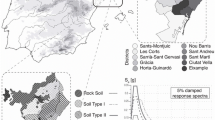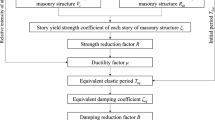Abstract
An unreinforced masonry (URM) structure damaged by a strong earthquake may be threatened by subsequent aftershocks in an unrepaired state. However, there is no consensus regarding whether aftershocks must be considered in the design and retrofitting of URM structures. This study aimed to comprehensively evaluate the seismic performance and explore the collapse mechanism of URM structures subjected to sequential ground motions. Therefore, a refined numerical model of a 5-story URM structure was established and verified using experiments. Fifteen as-recorded sequential ground motions were screened from several databases. By employing the incremental dynamic analysis approach for mainshocks and aftershocks separately, 900 samples of nonlinear structural responses under different sequential ground motions were obtained. The inter-story drift ratio (IDR) and damage index (DI) were adopted to assess the vulnerability of the URM structure. Moreover, the entire process from the cracking to collapse of a URM structure was simulated to investigate the collapse mechanism caused by aftershocks. The results indicated that a strong aftershock poses a significant threat to the URM structure, and the probability of severe damage and collapse increases significantly. The influence of strong aftershocks on the URM structure is more significant in the DI-based vulnerability assessment than in the IDR-based one. A strong aftershock significantly aggravates the damage to parts previously damaged by the mainshock and has less impact on the undamaged parts. We conclude that a strong aftershock should be considered in the design and retrofitting of URM structures.

















Similar content being viewed by others
References
Amadio C, Fragiacomo M, Rajgelj S (2003) The effects of repeated earthquake ground motions on the non-linear response of SDOF systems. Earthq Eng Struct Dyn 32:291–308
Ancheta TD, Darragh RB, Stewart JP, Seyhan E, Silva WJ, Chiou BS-J et al (2014) NGA-West2 database. Earthq Spectra 30:989–1005
Borzi B, Crowley H, Pinho R (2008) Simplified pushover-based earthquake loss assessment (SP-BELA) method for masonry buildings. Int J Archit Herit 2:353–376
Cecchi A, Sab K (2002) A multi-parameter homogenization study for modeling elastic masonry. Eur J Mech 21:249–268
Chen H, Xie Q, Li Z, Xue W, Liu K (2017) Seismic damage to structures in the 2015 Nepal earthquake sequences. J Earthq Eng 21:551–578
Chieffo N, Clementi F, Formisano A, Lenci S (2019) Comparative fragility methods for seismic assessment of masonry buildings located in Muccia (Italy). J Build Eng 25:100813
Cornell CA, Jalayer F, Hamburger RO, Foutch DA (2002) Probabilistic basis for 2000 SAC federal emergency management agency steel moment frame guidelines. J Struct Eng 128:526–533
Drougkas A, Roca P, Molins C (2015) Analytical micro-modeling of masonry periodic unit cells–Elastic properties. Int J Solids Struct 69:169–188
Fu Q, Qian J, Beskos DE (2018) Inelastic anisotropic constitutive models based on evolutionary linear transformations on stress tensors with application to masonry. Acta Mech 229:719–743
Gambarotta L, Lagomarsino S (1997) Damage models for the seismic response of brick masonry shear walls. Part II: the continuum model and its applications. Earthq Eng Struct Dyn 26:441–62
Gatta C, Addessi D, Vestroni F (2018) Static and dynamic nonlinear response of masonry walls. Int J Solids Struct 155:291–303
GB50011 CS (2010) Code for Seismic Design of Buildings. China Build Ind Press Beijing
Ghaisas KV, Basu D, Brzev S, Gavilán JJP (2017) Strut-and-Tie Model for seismic design of confined masonry buildings. Constr Build Mater 147:677–700
Godio M, Beyer K (2019) Evaluation of force-based and displacement-based out-of-plane seismic assessment methods for unreinforced masonry walls through refined model simulations. Earthq Eng Struct Dyn 48:454–475
Guo F, Wu D, Xu G, Ji Y (2011) Site classification corresponding relationship between Chinese and the overseas seismic design codes. J Civ Eng Manag 2:12
Haddadi H, Shakal A, Stephens C, Savage W, Huang M, Leith W, et al (2008) Center for engineering strong-motion data (CESMD). In: Proceedings of the 14th World Conference Earthquake Engineering, Beijing, China: pp 12–7
Han R, Li Y, van de Lindt J (2014) Assessment of seismic performance of buildings with incorporation of aftershocks. J Perform Constr Facil 29:4014088
Hatzigeorgiou GD, Beskos DE (2009) Inelastic displacement ratios for SDOF structures subjected to repeated earthquakes. Eng Struct 31:2744–2755
Hatzigeorgiou GD, Liolios AA (2010) Nonlinear behaviour of RC frames under repeated strong ground motions. Soil Dyn Earthq Eng 30:1010–1025
Hu S, Gardoni P, Xu L (2018) Stochastic procedure for the simulation of synthetic main shock-aftershock ground motion sequences. Earthq Eng Struct Dyn 47:2275–2296
Jeon J, DesRoches R, Lowes LN, Brilakis I (2015) Framework of aftershock fragility assessment–case studies: older California reinforced concrete building frames. Earthq Eng Struct Dyn 44:2617–2636
Jiang L, Wang Z, Zhang F (2018) Damage degree and inter-story drift angle limit of multi-story masonry structures. J Build Struct 39:263–270
Jiang L, Jiang L, Li X, Zhang F, Zheng S (2021) Shaking table test and seismic performance assessment of unreinforced multi-storey masonry residence. J Build Struct 42:25–35
Koutras AA, Shing PB (2020) Seismic behavior of a partially grouted reinforced masonry structure: Shake-table testing and numerical analyses. Earthq Eng Struct Dyn 49:1115–1136
Kumar N, Amirtham R, Pandey M (2014) Plasticity based approach for failure modelling of unreinforced masonry. Eng Struct 80:40–52
Kunnath SK, Reinhorn AM, Park YJ (1990) Analytical modeling of inelastic seismic response of R/C structures. J Struct Eng 116:996–1017
Lemos JV (2007) Discrete element modeling of masonry structures. Int J Archit Herit 1:190–213
Li Q, Ellingwood BR (2007) Performance evaluation and damage assessment of steel frame buildings under main shock–aftershock earthquake sequences. Earthq Eng Struct Dyn 36:405–427
Li J, Ren X (2009) Stochastic damage model for concrete based on energy equivalent strain. Int J Solids Struct 46:2407–2419
Li C, Chang K, Cao L, Huang Y (2021) Performance of a nonlinear hybrid base isolation system under the ground motions. Soil Dyn Earthq Eng 143:106589
Lourenço PB (1996) Computational strategies for masonry structures. Delft University of Technology, Netherlands
Luzi L, Puglia R, Russo E, D’Amico M, Felicetta C, Pacor F et al (2016) The engineering strong-motion database: A platform to access Pan-European accelerometric data. Seismol Res Lett 87:987–997
Mahin SA (1980) Effects of duration and aftershocks on inelastic design earthquakes. In: Proceedings of the 7th world conference on earthquake engineering, Istanbul, Turkey: pp 677–80.
Malena M, Portioli F, Gagliardo R, Tomaselli G, Cascini L, de Felice G (2019) Collapse mechanism analysis of historic masonry structures subjected to lateral loads: A comparison between continuous and discrete models. Comput Struct 220:14–31
Medeiros P, Vasconcelos G, Lourenço PB, Gouveia J (2013) Numerical modelling of non-confined and confined masonry walls. Constr Build Mater 41:968–976
Mercuri M, Pathirage M, Gregori A, Cusatis G (2021) On the collapse of the masonry Medici tower: An integrated discrete-analytical approach. Eng Struct 246:113046
Ministry of housing and urban-rural development of China (2021) General code for masonry structures. China Architecture and Building Press, Beijing, China
Moon L, Dizhur D, Senaldi I, Derakhshan H, Griffith M, Magenes G et al (2014) The demise of the URM building stock in Christchurch during the 2010–2011 Canterbury earthquake sequence. Earthq Spectra 30:253–276
Negro P (1997) Experimental assessment of the global cyclic damage of framed R/C structures. J Earthq Eng 1:543–562
NIED K-NET (2019) KiK-net. National Research Institute for Earth Science and Disaster Resilience. Natl Res Inst Earth Sci Disaster Resil http://www.kyoshin.bosai.go.jp/.
Noor-E-Khuda S, Dhanasekar M, Thambiratnam DP (2016) An explicit finite element modelling method for masonry walls under out-of-plane loading. Eng Struct 113:103–120
Oliveira DV, Lourenço PB (2004) Implementation and validation of a constitutive model for the cyclic behaviour of interface elements. Comput Struct 82:1451–1461
Pelà L, Cervera M, Roca P (2013) An orthotropic damage model for the analysis of masonry structures. Constr Build Mater 41:957–967
Pulatsu B, Bretas EM, Lourenco PB (2016) Discrete element modeling of masonry structures: Validation and application. Earthquakes Struct 11:563
Pulatsu B, Erdogmus E, Lourenço PB, Lemos JV, Tuncay K (2020) Simulation of the in-plane structural behavior of unreinforced masonry walls and buildings using DEM. Structures 27:2274–2287
Raghunandan M, Liel AB, Luco N (2015) Aftershock collapse vulnerability assessment of reinforced concrete frame structures. Earthq Eng Struct Dyn 44:419–439
Rinaldin G, Amadio C (2018) Effects of seismic sequences on masonry structures. Eng Struct 166:227–239
Rota M, Penna A, Magenes G (2014) A framework for the seismic assessment of existing masonry buildings accounting for different sources of uncertainty. Earthq Eng Struct Dyn 43:1045–1066
Ruiz-García J, Moreno JY, Maldonado IA (2008) Evaluation of existing Mexican highway bridges under mainshock-aftershock seismic sequences. In: Proceedings of 14th world conference on earthquake engineering, Beijing, China
Shen J, Ren X, Zhang Y, Chen J (2019) Nonlinear dynamic analysis of frame-core tube building under seismic sequential ground motions by a supercomputer. Soil Dyn Earthq Eng 124:86–97
Shen J, Ren X, Chen J (2021) Effects of spatial variability of ground motions on collapse behaviour of buildings. Soil Dyn Earthq Eng 144:106668
Shen J, Chen J, Ding G (2020) Random field model of sequential ground motions. Bull Earthq Eng, pp 1–23.
Tsai KC, Hsiao CP, Bruneau M (2000) Overview of building damages in 921 Chi-Chi earthquake. Earthq Eng Eng Seismol 2:93–108
Tzamtzis AD, Asteris PG (2004) FE analysis of complex discontinuous and jointed structural systems (Part 1: Presentation of the method-a state-of-the-art review). Electron J Struct Eng 1:75–92
Uva G, Sangiorgio V, Ruggieri S, Fatiguso F (2019) Structural vulnerability assessment of masonry churches supported by user-reported data and modern Internet of Things (IoT). Measurement 131:183–192
Wang X, Wen W, Zhai C (2020) Vulnerability assessment of a high-rise building subjected to mainshock–aftershock sequences. Struct Des Tall Spec Build 29:e1786
Wen W, Zhai C, Ji D (2018) Damage spectra of global crustal seismic sequences considering scaling issues of aftershock ground motions. Earthq Eng Struct Dyn 47:2076–2093
Wu J, Li J, Faria R (2006) An energy release rate-based plastic-damage model for concrete. Int J Solids Struct 43:583–612
Yacila J, Camata G, Salsavilca J, Tarque N (2019) Pushover analysis of confined masonry walls using a 3D macro-modelling approach. Eng Struct 201:109731
Zhai C, Wen W, Chen Z, Li S, Xie L (2013) Damage spectra for the mainshock–aftershock sequence-type ground motions. Soil Dyn Earthq Eng 45:1–12
Zhang Y, Chen J, Sun C (2017) Damage-based strength reduction factor for nonlinear structures subjected to sequence-type ground motions. Soil Dyn Earthq Eng 92:298–311
Zhang Y, Shen J, Chen J (2020a) Damage-based yield point spectra for sequence-type ground motions. Bull Earthq Eng 18:4705–4724
Zhang Y, Zhi X, Fan F (2020b) Fragility analysis of reticulated domes subjected to multiple earthquakes. Eng Struct 211:110450
Zizi M, Corlito V, Lourenço PB, De Matteis G (2021) Seismic vulnerability of masonry churches in Abruzzi region. Italy Structures 32:662–680
Acknowledgements
The authors gratefully acknowledge the financial support provided by the National Natural Science Foundation of China (Grant No. U1711264), Natural Science Foundation of Shanghai (Grant No. 21ZR1455000), and Tianshan Scholar Program at Xinjiang University.
Funding
Funding was provided by the National Natural Science Foundation of China (Grant No. U1711264), Natural Science Foundation of Shanghai (Grant No. 21ZR1455000), and Tianshan Scholar Program at Xinjiang University.
Author information
Authors and Affiliations
Contributions
JS: Software, Formal Analysis, Data Curation, Writing—Original Draft. YZ: Methodology, Supervision, Funding Acquisition. JC: Writing—Review & Editing, Supervision, Funding Acquisition.
Corresponding author
Ethics declarations
Conflict of interest
The authors declare that they have no known competing financial interests or personal relationships that could have appeared to influence the work reported in this paper.
Additional information
Publisher's Note
Springer Nature remains neutral with regard to jurisdictional claims in published maps and institutional affiliations.
Rights and permissions
Springer Nature or its licensor holds exclusive rights to this article under a publishing agreement with the author(s) or other rightsholder(s); author self-archiving of the accepted manuscript version of this article is solely governed by the terms of such publishing agreement and applicable law.
About this article
Cite this article
Shen, J., Zhang, Y. & Chen, J. Vulnerability assessment and collapse simulation of unreinforced masonry structures subjected to sequential ground motions. Bull Earthquake Eng 20, 8151–8177 (2022). https://doi.org/10.1007/s10518-022-01509-6
Received:
Accepted:
Published:
Issue Date:
DOI: https://doi.org/10.1007/s10518-022-01509-6




